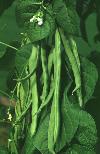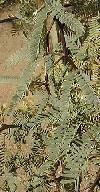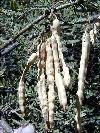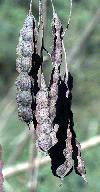| Plant Photo |
Scientific Name |
Common Name and Description |
Seed Photo |
 |
Acacia greggii |
Common Name: Catclaw Acacia, Catclaw, Devilsclaw, Gregg Catclaw, or Texas Catclaw
Leaves: Pinnae 1-3 pairs; leaflets 3 to 7 pairs, mostly 3-6 mm long, obovate to narrowly oblong, usually pallid-green, obtuse
Flowers: Creamy-white, in spikes about 1 cm thick and 2-6 times as long as thick;
Fruit: Pods flat, thin, usually falcate 5-8 cm long, 15-20 mm broad, only very late becoming rigid, brownish; seeds small and flat, not causing the pod to bulge
Habitat: Frequent in brushy vegetation
Range: Trans-Pecos and Rio Grande Plains, northeast as far as Taylor and Coleman counties; southern United States and northern Mexico
Group: Dicot
Family: Fabaceae
Growth Habit: Tree/Shrub - usually not more than 1-2 m tall, rounded and muched branched, formidably armed with recurved catclaw-like prickles
Duration: Perennial
U.S. Nativity: Native |
 |
 |
Medicago sativa |
Common Name: Alfalfa
Leaves: Leaflets 1-3 cm long 3-8 mm broad, obovate to oblong or oblanceolate
Flowers: Racemes crowded, 1-4 cm long, 1-2 cm thick, with 10 to 20 flowers; petals 7-12 mm long, violet-blue
Fruit: Pod loosely and spirally coiled in 1 or 2 turns, the coils about 4-5 mm in diameter, prickless
Habitat: Widespread as an escape along roadsides and in abandoned fields
Range: In Texas absent in only the Rio Grande Plains and Coastal Bend regions; very widely distributed as a forage crop and as a weed
Group: Dicot
Family: Fabaceae
Growth Habit: Forb/Herb - 3 to 10 dm tall
Duration: Perennial
U.S. Nativity: Introduced |
 |
 |
Phaseolus acutifolius |
Common Name: Tepary Bean
Leaves: Leaflets linear to lanceolate, sharply acute, 3-8 times as long as broad, rarely or perhaps never lobed
Flowers: 2 to 4 (sometimes 1) per inflorescence, 8-10 mm long at anthesis; calyx pubescent, about 4 mm long subequally 5-lobed, corolla creamy-blue to lavender;
Fruit: Pods curvilinear, 4-7 cm long
Habitat: Rare in canyons, Trans-Pecos mountains, 4,000-6,000 feet in elevation
Range: Texas, New Mexico, Arizona
Group: Dicot
Family: Fabaceae
Growth Habit: Vine/Forb/Herb - slender taproot
Duration: Annual
U.S. Nativity: Native |
 |
 |
Phaseolus vulgaris |
Common Name: Navy or Pea Bean, Red Kidney, Pinto, Great Northern, Marrow, and Yellow Eye Bean
Leaves: Alternate, petiolate, and once-pinnately-trifoliate
Flowers: Racemes axillary, ascending, long-pedunculate
Fruit: Linear, slightly laterally compressed
Habitat:
Range: North America and Caribbean
Group: Dicot
Family: Fabaceae
Growth Habit: Vine/Forb/Herb
Duration: Annual
U.S. Nativity: Introduced |
 |
 |
Prosopis juliflora |
Common Name: Mesquite
Leaves: Pinnae usually 1 pair per leaf, leaflets widely spaced, usually 6-15 pairs per pinna, foliage usually glabrous
Flowers: In spikes or heads, yellow or creamy-white
Fruit: Essentially straight, several seeded pod, nearly as thick as broad 7-20 cm long; seeds partitioned from each other and essentially embedded in fleshy parenchyma; probably the commonest "legume" in Texas
Habitat: Especially abundant on disturbed grasslands
Range: Abundant in the Rio Grande Plains, parts of north-central and southeast Texas, and Plains Country, scattered in the Trans-Pecos, east Texas and Edwards Plateau; in Kansas, Oklahoma, and east New Mexico, south into Mexico
Group: Dicot
Family: Fabaceae
Growth Habit: Tree/Shrub - small
Duration: Perennial
U.S. Nativity: Introduced |
 |
 |
Prosopis velutina |
Common Name: Velvet Mesquite
Leaves: Leaflets are generally short, hairy, and closely spaced; as opposed to those of honey mesquite which are long, linear, glabrous and widely spaced;
Flowers: In spikes or heads, yellow or creamy-white
Fruit: seeds are glossy brown, oval, 5-7 (mm0.2 to 0.28 inch) long and 4-5 (mm0.12 to 0.2 inch) wide
Habitat: Velvet mesquite occurs in low elevation vegetation area, in desert grasslands, along major water coarses and their tributaries, deciduous woodlands or "bosques" are often dominated by velvet mesquite
Range: A small, isolated population occurs in the Rio Grande Valley, near El Paso, Texas, thought to be introduced; the main distribution is confined to central and southern Arizona, extreme southwestern New Mexico, and adjacent northern Mexico; the Continental Divide forms a natural boundary between populations of velvet mesquite and honey mesquite; in California, velvet mesquite is represented by only a few individuals that occur in Imperial, Riverside, and Kern counties and is believed to be from human introductions
Group: Dicot
Family: Fabaceae
Growth Habit: Tree/Shrub - a deciduous, thorny shrub or small tree, may grow into single-stemmed trees up to 15 m (50 feet) tall with a trunk diameter up to about 61 cm (2 feet) or they may develop into an erect, multistemmed bush
Duration: Perennial
U.S. Nativity: Native |
 |
 |
Sesbania drummondii |
Common Name: Rattlebush, Poison Bean, or Coffee Bean
Leaves: Mostly 1-2 dm long; leaflets 20-50 mostly 15-35 mm long and 4-7 mm broad
Flowers: 13-16 mm long yellow, often with red lines
Fruit: 5-6 cm long about 1 cm broad; the seeds are loose in the mature pods which rattle when the bush is in motion; known to be poisonous to sheep and goats
Habitat: In disturbed areas and wastelands
Range: Coastal Plain inland to Denton, Williamson, Travis, Comal, Wilson, McMullen and Starr counties in Texas; Louisiana, Mississippi, Alabama, Florida, Arkansas
Group: Dicot
Family: Fabaceae
Growth Habit: Subshrub/Shrub - in the northern regions the branches often die back during the winter, only the lowest part of the plant remaining alive and becoming woody, 4-30 dm tall
Duration: Perennial
U.S. Nativity: Native |
 |
 |
Sophora secundiflora |
Common Name: Texas Mountain Laurel, Mescal Bean or Frijolillo
Leaves: Leaflets very firm, 5 to 11 per leaf, often 17 mm broad or broader and glabrous above
Flowers: Racemes 5-15 cm long and 5-10 cm broad, bluish-purple and very showy, the individual flowers 1-2 cm long
Fruit: Woody pods 2-12 cm long and 1 mm thick or thicker, moderately constricted between the seeds; seeds red
Habitat: Frequent in brushy vegetation
Range: South edge of Edwards Plateau north to Travis county and in the caliche areas in the Rio Grande Plains, scattered in west part of Edwards Plateau and Trans-Pecos mountains in Texas; west to New Mexico
Group: Dicot
Family: Fabaceae
Growth Habit: Tree/Shrub - evergreen, 5-35 dm tall, usually with dense glossy foliage
Duration: Perennial
U.S. Nativity: Native |
 |

